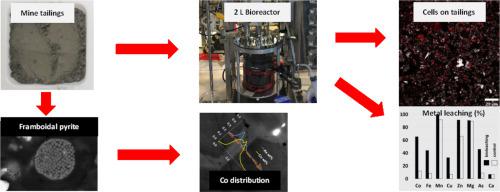当前位置:
X-MOL 学术
›
Hydrometallurgy
›
论文详情
Our official English website, www.x-mol.net, welcomes your feedback! (Note: you will need to create a separate account there.)
Bioleaching of cobalt from Cu/Co-rich sulfidic mine tailings from the polymetallic Rammelsberg mine, Germany
Hydrometallurgy ( IF 4.7 ) Pub Date : 2020-11-01 , DOI: 10.1016/j.hydromet.2020.105443 Ruiyong Zhang , Sabrina Hedrich , Felix Römer , Daniel Goldmann , Axel Schippers
Hydrometallurgy ( IF 4.7 ) Pub Date : 2020-11-01 , DOI: 10.1016/j.hydromet.2020.105443 Ruiyong Zhang , Sabrina Hedrich , Felix Römer , Daniel Goldmann , Axel Schippers

|
Abstract A microbial consortium of mesophilic and acidophilic bacteria and archaea was applied in shake flasks as well as in 2 L stirred tank reactors (STR) to bioleach cobalt, copper, and other valuable metals from sulfidic mine tailings (Rammelsberg polymetallic massive sulfide deposit, Harz Mountains, Germany). After succession from low to high pulp density, the microbial consortium was well adapted to 10% pulp density and showed high bioleaching efficiency. Microbial activity and abundance were measured by microcalorimetry, microscopy, and quantitative, real-time PCR. The adapted mesophilic microbial consortium consisted mainly of Acidithiobacillus (At.) ferrooxidans and At. thiooxidans which achieved 91% cobalt and 57% copper extraction from the bulk tailings (Co 0.02%; Cu 0.12%) after 13 days in STR. Bioleaching tests with a tailings flotation concentrate (Co 0.06%; Cu 0.57%) showed a recovery of 66% cobalt and 33% copper. In addition, mineralogical analysis showed that cobalt occurred on the surface of framboidal pyrite and was mainly leached by microbial attack. Attached cells were microscopically observed on the surface of solid particles of the bulk tailings and tailings flotation concentrate. The amount of sulfides (mainly pyrite) in the tailings was sufficient to sustain microbial growth and thus no additional substrate was required for tailings bioprocessing. Bioleaching is considered to be an important processing step in the concept for reprocessing of the Rammelsberg mine tailings, and for many sulfidic mine tailings worldwide.
中文翻译:

从德国 Rammelsberg 多金属矿的富铜/钴硫化矿尾矿中生物浸出钴
摘要 在摇瓶和 2 L 搅拌釜反应器 (STR) 中应用嗜温和嗜酸细菌和古细菌的微生物聚生体,从硫化矿尾矿(Rammelsberg 多金属块状硫化物矿床,Harz山脉,德国)。在从低到高的纸浆密度连续后,微生物群落很好地适应了 10% 的纸浆密度,并表现出较高的生物浸出效率。通过微量热法、显微镜和定量实时 PCR 测量微生物活性和丰度。适应的嗜温微生物群落主要由氧化亚铁酸硫杆菌 (At.) 和 At. 组成。在 STR 中 13 天后,从散装尾矿(Co 0.02%;Cu 0.12%)中提取了 91% 的钴和 57% 的铜。使用尾矿浮选精矿(Co 0.06%;Cu 0.57%)进行的生物浸出试验表明回收了 66% 的钴和 33% 的铜。此外,矿物学分析表明,钴存在于菱形黄铁矿表面,主要受微生物侵袭浸出。在散装尾矿和尾矿浮选精矿的固体颗粒表面用显微镜观察附着的细胞。尾矿中硫化物(主要是黄铁矿)的含量足以维持微生物的生长,因此尾矿生物处理不需要额外的底物。生物浸出被认为是 Rammelsberg 尾矿后处理概念中的重要处理步骤,以及世界范围内许多硫化矿尾矿。矿物学分析表明,钴存在于菱形黄铁矿表面,主要受微生物侵袭浸出。在散装尾矿和尾矿浮选精矿的固体颗粒表面用显微镜观察附着的细胞。尾矿中硫化物(主要是黄铁矿)的含量足以维持微生物的生长,因此尾矿生物处理不需要额外的底物。生物浸出被认为是 Rammelsberg 尾矿后处理概念中的重要处理步骤,以及世界范围内许多硫化矿尾矿。矿物学分析表明,钴存在于菱形黄铁矿表面,主要受微生物侵袭浸出。在散装尾矿和尾矿浮选精矿的固体颗粒表面用显微镜观察附着的细胞。尾矿中硫化物(主要是黄铁矿)的含量足以维持微生物的生长,因此尾矿生物处理不需要额外的底物。生物浸出被认为是 Rammelsberg 尾矿后处理概念中的重要处理步骤,以及世界范围内许多硫化矿尾矿。在散装尾矿和尾矿浮选精矿的固体颗粒表面用显微镜观察附着的细胞。尾矿中硫化物(主要是黄铁矿)的含量足以维持微生物的生长,因此尾矿生物处理不需要额外的底物。生物浸出被认为是 Rammelsberg 尾矿后处理概念中的重要处理步骤,以及世界范围内许多硫化矿尾矿。在散装尾矿和尾矿浮选精矿的固体颗粒表面用显微镜观察附着的细胞。尾矿中硫化物(主要是黄铁矿)的含量足以维持微生物的生长,因此尾矿生物处理不需要额外的底物。生物浸出被认为是 Rammelsberg 尾矿后处理概念中的重要处理步骤,以及世界范围内许多硫化矿尾矿。
更新日期:2020-11-01
中文翻译:

从德国 Rammelsberg 多金属矿的富铜/钴硫化矿尾矿中生物浸出钴
摘要 在摇瓶和 2 L 搅拌釜反应器 (STR) 中应用嗜温和嗜酸细菌和古细菌的微生物聚生体,从硫化矿尾矿(Rammelsberg 多金属块状硫化物矿床,Harz山脉,德国)。在从低到高的纸浆密度连续后,微生物群落很好地适应了 10% 的纸浆密度,并表现出较高的生物浸出效率。通过微量热法、显微镜和定量实时 PCR 测量微生物活性和丰度。适应的嗜温微生物群落主要由氧化亚铁酸硫杆菌 (At.) 和 At. 组成。在 STR 中 13 天后,从散装尾矿(Co 0.02%;Cu 0.12%)中提取了 91% 的钴和 57% 的铜。使用尾矿浮选精矿(Co 0.06%;Cu 0.57%)进行的生物浸出试验表明回收了 66% 的钴和 33% 的铜。此外,矿物学分析表明,钴存在于菱形黄铁矿表面,主要受微生物侵袭浸出。在散装尾矿和尾矿浮选精矿的固体颗粒表面用显微镜观察附着的细胞。尾矿中硫化物(主要是黄铁矿)的含量足以维持微生物的生长,因此尾矿生物处理不需要额外的底物。生物浸出被认为是 Rammelsberg 尾矿后处理概念中的重要处理步骤,以及世界范围内许多硫化矿尾矿。矿物学分析表明,钴存在于菱形黄铁矿表面,主要受微生物侵袭浸出。在散装尾矿和尾矿浮选精矿的固体颗粒表面用显微镜观察附着的细胞。尾矿中硫化物(主要是黄铁矿)的含量足以维持微生物的生长,因此尾矿生物处理不需要额外的底物。生物浸出被认为是 Rammelsberg 尾矿后处理概念中的重要处理步骤,以及世界范围内许多硫化矿尾矿。矿物学分析表明,钴存在于菱形黄铁矿表面,主要受微生物侵袭浸出。在散装尾矿和尾矿浮选精矿的固体颗粒表面用显微镜观察附着的细胞。尾矿中硫化物(主要是黄铁矿)的含量足以维持微生物的生长,因此尾矿生物处理不需要额外的底物。生物浸出被认为是 Rammelsberg 尾矿后处理概念中的重要处理步骤,以及世界范围内许多硫化矿尾矿。在散装尾矿和尾矿浮选精矿的固体颗粒表面用显微镜观察附着的细胞。尾矿中硫化物(主要是黄铁矿)的含量足以维持微生物的生长,因此尾矿生物处理不需要额外的底物。生物浸出被认为是 Rammelsberg 尾矿后处理概念中的重要处理步骤,以及世界范围内许多硫化矿尾矿。在散装尾矿和尾矿浮选精矿的固体颗粒表面用显微镜观察附着的细胞。尾矿中硫化物(主要是黄铁矿)的含量足以维持微生物的生长,因此尾矿生物处理不需要额外的底物。生物浸出被认为是 Rammelsberg 尾矿后处理概念中的重要处理步骤,以及世界范围内许多硫化矿尾矿。



























 京公网安备 11010802027423号
京公网安备 11010802027423号